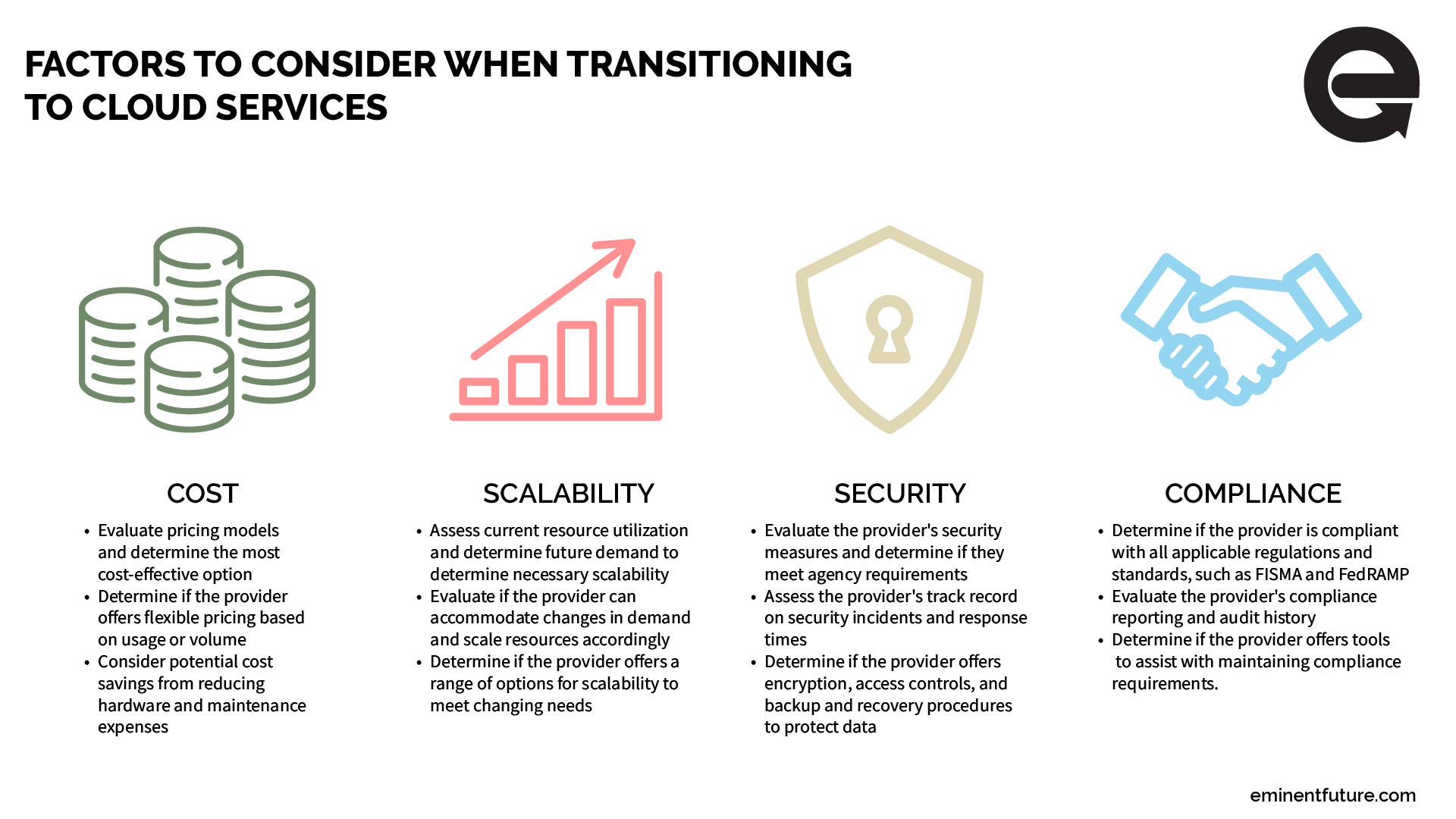Federal agencies are under increasing pressure to maximize their IT resources while keeping costs low. One solution that’s gaining popularity is transitioning to cost-effective commercial cloud services.
Cloud services offer numerous benefits, including lower upfront costs, greater scalability and flexibility, improved security measures, and increased cost efficiency.

However, to make the transition successful, federal directors must consider several key factors, such as resource utilization, vendor options, quality assurance, and service level agreements. This article will explore the advantages of transitioning IT resources to cloud services and provide a comprehensive plan for federal agencies to transition successfully.
We’ll discuss how to assess current resource utilization and performance, research the various options available, and establish quality assurance measures.
We’ll also provide the following:
- Tips for selecting the right vendor.
- Negotiating service-level agreements.
- Ensuring a smooth transition for employees.
By following this plan, federal agencies can unlock the full potential of cloud services while ensuring cost savings and operational efficiency. Welcome to the cloud!
Factors to Consider for Cloud Services Transition

Federal agencies need to carefully consider several factors before transitioning to cloud services. Firstly, they must assess their existing IT infrastructure to identify areas where additional capacity may be required.
These areas include evaluating current resource utilization and performance, determining the most critical applications, and estimating future demand. By understanding these factors, federal directors can identify gaps in their infrastructure and plan accordingly.
Next, research is vital in finding the right cloud service provider that meets their needs. Agencies must evaluate cost, scalability, security, and compliance. The vendor they choose should offer integration with existing systems to avoid disrupting critical processes.
Additionally, federal agencies should assess the vendor’s track record, including uptime and incident response, to ensure they have the necessary expertise and resources to support their IT needs. By carefully selecting the right vendor, federal agencies can successfully transition to cloud services.
Finally, security and compliance are essential factors when transitioning to cloud services. Federal agencies must ensure that their chosen vendor meets their specific security and compliance requirements. Compliance includes evaluating data protection measures such as encryption, access controls, and backup and recovery procedures.
Agencies must ensure that the vendor complies with applicable regulations and standards, such as FISMA and FedRAMP. By taking a proactive approach to security and compliance, federal agencies can ensure that their data remains secure while taking advantage of cloud services’ benefits.
Mitigating Risks and Challenges in Cloud Services Transition

As with significant IT changes, transitioning to cloud services can present considerable challenges and risks for federal agencies. Data security is one of the most significant risks, as sensitive government data must be kept secure and compliant with various regulations.
This is especially important when outsourcing data storage and management to a third-party cloud service provider. Agencies should thoroughly research potential vendors and assess their security measures, including encryption, firewalls, and access controls. Additionally, they should evaluate the vendor’s compliance with relevant regulations, such as FedRAMP and FISMA, to ensure they meet the necessary security standards.
Another challenge is the potential for integration issues when moving to cloud services. Federal agencies must ensure that their new cloud systems integrate seamlessly with existing systems to avoid disruptions to critical processes.
Furthermore, they should be mindful of vendor lock-in, which can limit their flexibility and control over their IT infrastructure. To mitigate these risks, federal directors should carefully evaluate vendor offerings, including their support for open standards and willingness to work with multiple cloud platforms. By carefully managing these challenges and risks, federal agencies can successfully transition to cloud services while minimizing potential disruptions and costs.
Final Thoughts and Recommendations
In conclusion, transitioning to cloud services can offer numerous benefits to federal agencies. These include lower upfront costs, greater scalability and flexibility, improved security measures, and increased cost efficiency.
However, federal directors must consider several critical factors before switching, such as assessing existing IT infrastructure, researching vendors, evaluating security and compliance requirements, and ensuring integration with existing systems. By taking a proactive approach and carefully considering these factors, federal agencies can achieve a successful transition to cloud services.
The following steps for federal agencies may include the following:
- Conducting a pilot test of the cloud service.
- Monitoring performance metrics.
- Seeking end-user feedback to ensure a successful transition.
Continuously assessing and optimizing resource utilization is also essential to ensure cost efficiency.
With the right approach, transitioning to cloud services can help federal agencies unlock the full potential of their IT resources and improve operational efficiency while keeping costs low. We encourage readers to consider the benefits of cloud services and take the necessary steps to make the switch.
Key Takeaways




